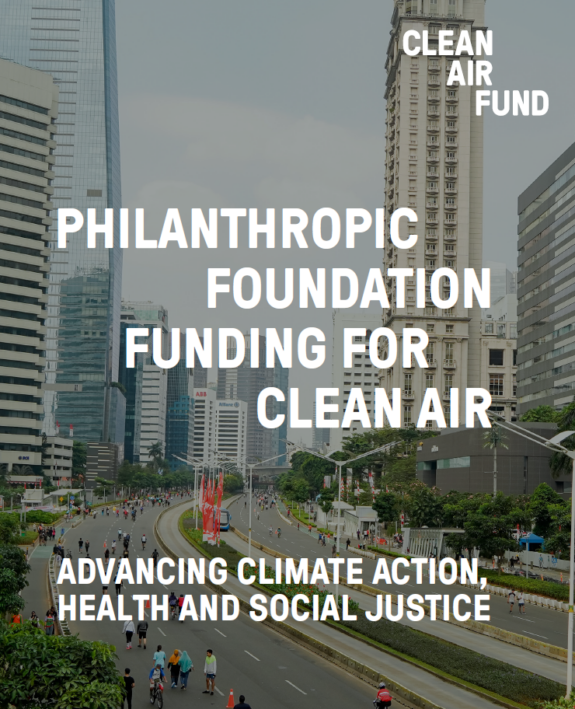
Funding to improve outdoor air quality could help mitigate climate change, transform nations’ health and enhance social justice. This is because the factories, houses and vehicles that emit harmful air pollutants also pump greenhouse gases into the air – and the damaging impacts of dirty air and climate change are felt most keenly by the poorest and most vulnerable in society. By investing in clean air projects, funders can contribute to meeting several UN Sustainable Development Goals (SDGs) at once.
The technology and approaches required to address the air pollution crisis already exist. But a number of obstacles stand in the way of utilising these solutions, namely funding challenges, impediments to policy implementation and political issues. Philanthropic foundations are well placed to be catalysts for wider scale action, as they can be more nimble than other funding bodies and can add value to their giving through innovation, advocacy and influence. This report, part of the The State of Global Air Quality Funding series, showcases financial trends and examples of where funding air quality has had a significant impact and delivered co-benefits for multiple problems. It also provides recommendations for how philanthropic funders can fund clean air for the greatest impact.
Trends in air quality funding
A total of $330 million of known funding went to air quality projects between 2015 and 2022. Since 2015, the level of investment for air quality projects has more than quadrupled, indicating funders’ growing commitment. However, the level of funding from foundations in 2022, estimated at $71.3 million, has increased only slightly since 2021, suggesting a slowdown in year-on-year growth.
Outdoor air quality funding continues to account for less than 0.1% of all philanthropic foundation funding. Similarly, The State of Global Air Quality Funding 2023 report shows that air quality projects are neglected by international development funders, with only 1% of international development funding ($17.3 billion) and 2% of international public climate finance ($11.6 billion) going towards tackling air pollution between 2015 and 2021.
The total number of funders and grantees in the air quality field has risen consistently since 2015. Our research identified 79 foundations providing funding for air quality initiatives between 2015 and 2022, which was shared by 742 grantees. 1,638 different grant commitments were made, indicating that foundations are either funding the same organisation for multiple independent projects, providing follow-on grants to grantees, or that the same grantees are receiving funding from multiple foundations. This suggests there is significant scope for the clean air field to expand.
Newcomers and regranters spur growth
Foundations new to air quality and more funding channelled through regranters are stimulating growth. Large funds from newcomers, like Bezos Earth Fund, the Earthshot Prize and Open Philanthropy, contributed to the jump in funding for clean air initiatives between 2020 and 2021.
In 2021 and 2022, more than $30 million of philanthropic foundation funding was invested through regranters. Regranting and the use of pooled funds is a growing trend across philanthropy. Expert regranters enable greater leveraging of capital, experience and expertise to help scale up proven solutions quickly. For an underfunded and cross-cutting field like air quality, re-granting presents a way for foundations with multiple relevant but tangential interests to engage without generating explicit new programme areas.
Some of the top air quality funders are named in the report and include Bezos Earth Fund and Impact on Urban Health. In 2022, the Clean Air Fund was the largest philanthropic funder dedicated to tackling air pollution globally.
Climate, energy, social justice and health funders invest in clean air
Foundations focusing on climate, energy and environment (CEE) provided the highest amount of funding to air quality initiatives, accounting for 77% of overall funding between 2015 and 2022. Foundations motivated by enhancing social equity and public health provided the second and third highest funding for tackling air pollution.
Most polluted regions get the least funding
Philanthropic funding for air quality is particularly low for Africa, Latin America and parts of Asia (excluding China and India). Africa and Latin America received only 1% ($1.9 million) and 2% ($5.7 million) of the total funding (2015-2022). Most funding to Latin America comes from foundations based in Latin America, primarily Brazil and Mexico.
Which types of projects are being funded?
Effective action on air pollution requires funding across an array of project types. Our findings show that the most funded types of clean air projects are communications and awareness, research and policy initiatives.
Types of projects needed to address air pollution
- Data: to improve the quality, quantity or transparency of, or access to, information
- Impacts and research: to increase research into and enhance understanding of the impacts of air pollution on health, the environment and the economy
- Communications and awareness: to raise awareness of air pollution, including through campaigning, communications and events
- Policy and governance: to develop, promote and transform public policies on air quality
- Infrastructure: to invest in implementing infrastructure and technology aimed at improving air quality
- Multiple/undefined: incorporating supporting the core costs of an organisation focused on air quality (including field building), situations where multiple strategies were supported or where it was not possible to assign an activity type.
Air quality data projects receive comparably less funding. Air quality data underpins action on clean air, yet major data gaps exist at both global and local scales. Analysis from the Energy Policy Institute at the University of Chicago highlights that an investment of $4-8 million per year towards air quality data programmes would create opportunities for pollution improvements for nearly 1 billion people. Investments in sustained air quality monitoring, open data and community engagement can have a national-level impact and present major opportunities for philanthropy to catalyse change.
Recommendations
- Philanthropic foundations, particularly those committed to addressing climate change, social injustice or improving public health, should increase their funding to air quality projects through their own grant making, or via intermediaries such as a pooled fund or re-granter, such as the Clean Air Fund.
- Foundations should channel their funding to where it is most needed. For example, investing in underfunded countries and regions, specifically Africa, Latin America and parts of Asia where air quality is poor and rapidly getting worse. Foundations should also invest in air quality data, among other focus areas, to create a multiplier effect.
- Philanthropic funders should bring their unique expertise, networks and influence to help tackle air pollution as part of addressing climate change, public health and social inequalities. Depending on a philanthropic foundation’s strategy, experience and expertise, this might include: making the case for action on this cross-cutting issue and exploring synergies within existing grant making, and acting as convenors to bring together various stakeholders to collaborate on solutions.
See our full recommendations for philanthropic foundations in the report.


